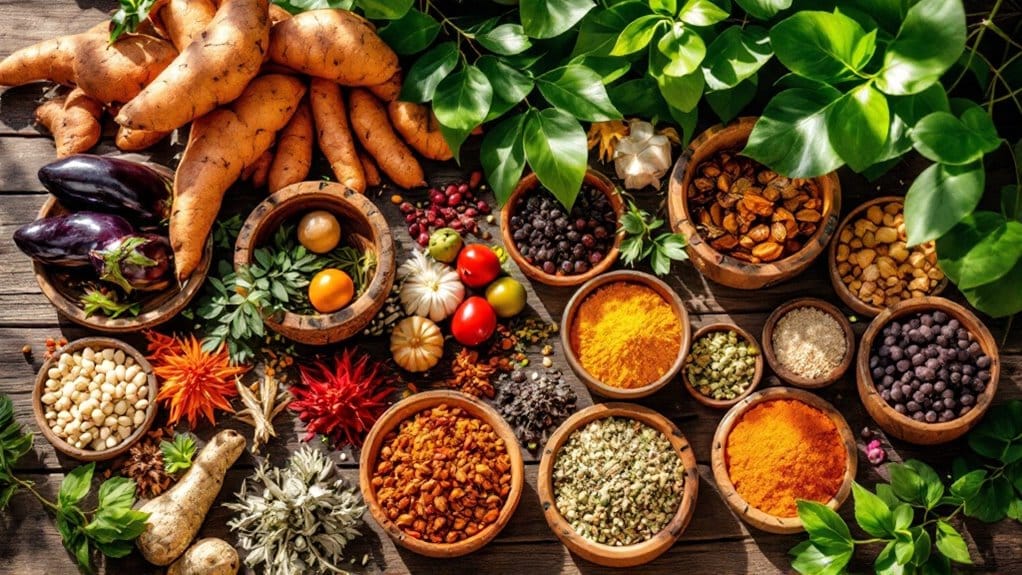When you explore Indigenous ingredients in African cuisine, you reveal a world of vibrant flavors and rich traditions. Staples like millet, sorghum, and cassava not only offer nutrition but also connect you to local cultures and their agricultural practices. Each region showcases unique ingredients, like fonio in West Africa or coconut milk in East Africa, which enhance the diversity of dishes. Traditional cooking methods further enrich these foods, ensuring the essence of culinary heritage shines through. By embracing these ingredients, you're part of a growing movement that values sustainability and community, revealing even more fascinating insights along the way.
Key Takeaways
- Indigenous ingredients like millet, cassava, and sorghum provide essential nutrients, supporting health and nutrition in African cuisine.
- Traditional cooking techniques, such as slow cooking and open fire cooking, enhance flavors and preserve culinary heritage.
- Regional variations showcase local cultures, with unique ingredients and methods, from West Africa's Jollof rice to East Africa's coconut milk dishes.
- Modern adaptations incorporate indigenous ingredients into contemporary dishes, making them versatile for today's culinary trends.
- Sustainable farming practices promote food security and biodiversity, ensuring the resilience of local agricultural systems and indigenous food sources.
Indigenous Ingredients in African Cuisine
When you explore African cuisine, you'll quickly discover that indigenous ingredients play an essential role in shaping its diverse flavors and textures. Staples like millet and cassava serve as the foundation for many traditional recipes, bringing nutrition and heartiness to meals.
You'll find that native oils, such as palm oil, not only enhance flavor but also offer significant nutritional benefits, making your dishes healthier.
As you dive deeper, you'll encounter a rich tapestry of spices that set regional dishes apart. Grains of paradise, Ethiopian berbere, and Moroccan ras el hanout add unique profiles that excite the palate.
Don't forget about the vibrant vegetables like kale, amaranth, and African eggplant, which showcase local agricultural practices and provide essential nutrients.
Herbs such as African basil and lemongrass contribute depth and aroma, reflecting the connection between communities and their environment.
Embracing these indigenous ingredients allows you to celebrate the culinary heritage of Africa while enjoying the flavors that bind communities together.
Cultural Significance of Indigenous Foods
Celebrating indigenous foods in African cuisine reveals their profound cultural significance and connection to community identity. These indigenous ingredients, like millet, cassava, and yams, aren't just staples; they're the heart of local diets and a reflection of agricultural practices that have sustained generations.
When you savor traditional dishes prepared with palm oil or spices like berbere and harissa, you're not just tasting flavor; you're experiencing a rich tapestry of culinary heritage that binds communities together.
These foods often play crucial roles in cultural rituals and celebrations, reinforcing social bonds that bring people closer. Through shared meals, families pass down traditions, ensuring that the essence of their culinary identity thrives.
The diversity of flavors and techniques found across Africa showcases a wealth of knowledge passed down through time, reminding you of the unique stories behind each ingredient.
Key Indigenous Plants and Grains
When exploring key indigenous plants and grains, you'll discover the remarkable nutritional benefits they offer.
Grains like sorghum and fonio not only provide essential nutrients but also adapt well to challenging growing conditions.
Additionally, traditional uses of these plants vary by region, showcasing the rich diversity of African cuisine.
Nutritional Benefits of Grains
Indigenous grains like millet, sorghum, and teff not only provide essential nutrients but also play an important role in the diets of many African communities.
These grains are rich in protein, fiber, and a variety of vitamins and minerals, making them crucial for a balanced diet. For instance, teff, a staple in Ethiopia, stands out due to its high calcium content and amino acids, supporting bone health and muscle development.
Sorghum is another fantastic option; it's gluten-free and boasts a low glycemic index, making it perfect for those with gluten sensitivities or managing blood sugar levels.
Meanwhile, millet shines with its antioxidants and phytochemicals, which can reduce the risk of chronic diseases like heart disease and diabetes, while also promoting digestive health.
Traditional Plant Uses
Many traditional African dishes rely on a variety of indigenous plants and grains, each with unique qualities that contribute to local diets and cultural practices.
These plants not only nourish the body but also weave a sense of community and belonging among people.
Here are some key ingredients that play an essential role:
- Fonio: A nutrient-rich ancient grain, celebrated for its resilience to drought and a staple in West African diets.
- Baobab tree: Known as the "tree of life," its fruit and leaves add vibrancy and nutrition to traditional dishes.
- Cassava: A drought-resistant tuber that serves as a primary carbohydrate source, often transformed into beloved fufu.
- Sorghum: This versatile grain provides essential food security and is enjoyed in porridge and traditional brews.
- Indigenous legumes: Cowpeas and pigeon peas boast high protein content and enrich the soil, supporting sustainable agricultural practices.
These traditional plant uses embody the essence of African cuisine, ensuring food security and fostering a deep connection to the land and heritage.
Embracing these ingredients not only nourishes you but also strengthens the bonds of community.
Regional Plant Variations
Across the diverse landscapes of Africa, regional plant variations play a crucial role in shaping local cuisines. When you explore these variations, you'll discover how indigenous grains like millet, sorghum, and teff serve as essential staples, offering not just flavor but significant nutritional benefits.
In West Africa, fonio shines as a fast-growing ancient grain, thriving in poor soil and becoming a sustainable choice for many families. Meanwhile, in Central and West Africa, cassava stands tall as a drought-resistant root vegetable, providing a primary source of carbohydrates and featuring prominently in beloved dishes like fufu and gari.
In East Africa, sorghum isn't just for porridge and bread; it transforms into traditional beverages like ajon, showcasing its remarkable versatility. Don't forget the oil palm tree, native to West Africa, which brings a rich depth of flavor to various dishes through palm oil.
This ingredient forms the base of many traditional soups and stews, enhancing the culinary experience. By embracing these regional variations, you not only celebrate the rich tapestry of African cuisine but also connect with the culture and communities that cherish these indigenous ingredients.
Traditional Cooking Techniques
When you explore traditional African cooking techniques, you'll notice the prominence of open fire cooking, which adds a smoky depth to your dishes.
Slow cooking methods, often using clay pots, allow flavors to meld beautifully over time.
These techniques not only enhance taste but also carry rich cultural significance, connecting you to generations of culinary heritage.
Open Fire Cooking
Open fire cooking remains a cornerstone of African culinary traditions, as it allows you to prepare a variety of dishes over wood or charcoal flames. This traditional technique not only imparts a distinct smoky flavor but also connects you to the rich tapestry of indigenous culinary practices.
You'll find that using clay pots enhances the experience, as the gentle heat distribution makes for hearty stews and soups that warm both body and soul.
- It fosters community connections through shared meals.
- Each dish tells a story of cultural significance.
- You can feel the warmth of tradition in every bite.
- The skill of meal preparation becomes a cherished art form.
- It keeps culinary heritage alive for future generations.
Open fire cooking showcases the resourcefulness and adaptability of African communities. As you embrace these traditional techniques, you help preserve the authenticity and continuity of ethnic cooking passed down through generations.
Each time you gather around the flames, you're not just cooking; you're participating in a time-honored ritual that strengthens bonds, honors ancestry, and celebrates the flavors of Africa.
Slow Cooking Methods
Embracing slow cooking methods in African cuisine not only enhances the flavors of your meals but also deepens your connection to cultural traditions. This technique often involves using clay pots, which distribute heat gently, allowing your stews and soups to develop rich, complex flavors.
As you mix indigenous ingredients like native oils, spices, and local vegetables, you're not just cooking; you're preserving a cultural heritage that has been passed down through generations.
Traditional African slow cooking requires patience and skill, reflecting the importance of detail in your culinary journey. It's a method that connects modern practices to ancient techniques, ensuring the authenticity of your dishes.
Plus, slow cooking is practical; it allows you to prepare meals ahead of time, making it perfect for communal gatherings.
These gatherings emphasize sharing and togetherness, inviting everyone to enjoy the diverse culinary landscape that African cuisine offers.
Regional Variations in Ingredients
Africa's rich culinary landscape showcases distinct regional variations in ingredients that reflect its diverse cultures and climates. Each region has its own unique culinary identity shaped by indigenous practices and local resources.
- The comforting warmth of semolina in North African cuisine.
- The vibrant flavors of traditional West African staples like Jollof rice.
- The inviting aroma of coconut milk in East African essentials.
- The heartiness of cassava and plantains in Central African components.
- The savory delight of Southern African flavor profiles featuring boerewors.
In North Africa, spices like cumin and coriander enhance tagines and stews, while West African staples rely heavily on tomatoes and aromatic spices.
East African essentials, influenced by coastal trade, blend spices from Indian and Middle Eastern cuisines.
Central Africa embraces ingredients like peanuts in dishes such as Ndolé, while Southern Africa boasts maize for pap and biltong, showcasing a rich blend of cultural influences.
These regional variations not only celebrate the richness of African cuisine but also create a sense of belonging, connecting you to the heart and soul of each community's culinary heritage.
Nutritional Benefits of Indigenous Foods
Indigenous foods offer a wealth of nutritional benefits that can enhance your overall health and well-being. By incorporating ingredients like teff, sorghum, and millet into your meals, you're tapping into a rich source of protein, fiber, and essential vitamins. These grains not only nourish your body but also keep you feeling full and satisfied.
Don't forget about the powerhouse fruits and greens like baobab fruit and moringa leaves. They're loaded with antioxidants, which can help boost your immune system and fight off disease.
When cooking, consider using healthy oils like palm oil, which provides beneficial fats, including omega-6 fatty acids that support heart health.
Adding indigenous vegetables such as amaranth or African nightshade to your diet can considerably increase your intake of vitamins A, C, and K, along with calcium and iron.
Plus, traditional legumes like cowpeas and pigeon peas are fantastic sources of plant-based protein and fiber, enhancing digestion and promoting a sense of fullness.
Modern Uses of Indigenous Ingredients
In today's culinary world, chefs and home cooks alike are rediscovering the vibrant flavors and nutritional benefits of traditional ingredients. Indigenous ingredients like teff, fonio, and sorghum are making their way into modern dishes, providing gluten-free alternatives that cater to health-conscious menus.
This resurgence reflects a larger movement toward sustainable eating and an appreciation for local agricultural practices.
- Experience the nutty richness of fonio in a contemporary salad.
- Savor the boldness of palm oil drizzled over roasted vegetables.
- Delight in the warmth of traditional spices like berbere in fusion tacos.
- Revel in the texture of ancient grains like millet in your favorite bowl.
- Enjoy modern snacks crafted from cassava that bridge past and present.
Chefs creatively blend traditional spices with modern culinary techniques, crafting innovative dishes that resonate with both local roots and global palates.
Street food vendors are embracing indigenous ingredients, turning classics like plantains into trendy bites that speak to contemporary eating habits.
Sustainable Farming Practices
The culinary revival of indigenous ingredients goes hand-in-hand with a growing awareness of sustainable farming practices. You'll find that many African communities embrace traditional practices that prioritize crop diversity and resilience against environmental challenges. By using indigenous seeds, these farmers cultivate crops well-adapted to local climates, ensuring food security and maintaining genetic diversity.
Here's a snapshot of sustainable farming practices you might encounter:
| Practice | Benefits | Community Impact |
|---|---|---|
| Mixed Cropping | Enhances soil fertility, reduces pests | Strengthens community ties |
| Agroforestry | Improves biodiversity, provides additional resources | Supports local economies |
| Shifting Cultivation | Maintains ecosystem balance | Promotes knowledge sharing |
| Community Cooperatives | Encourages organic farming methods | Empowers local farmers |
These community-led initiatives foster a sense of belonging while promoting sustainable agriculture. By integrating trees with crops, farmers not only enhance their harvests but also help combat climate change through carbon sequestration. Embracing these practices means nurturing the land and building a future where everyone thrives together.
Celebrating Culinary Heritage
Celebrating culinary heritage means honoring the rich tapestry of flavors and techniques that define African cuisine. By embracing indigenous ingredients like palm oil, shea butter, and native spices, you elevate the nutritional value and taste of traditional dishes.
Each region's unique agricultural practices, from cultivating millet to harvesting cassava, reflect the deep connection to cultural identity and history.
As you explore these authentic African culinary traditions, consider the emotional resonance they carry:
- The warmth of family gatherings around a clay pot.
- The aroma of spices wafting through your childhood home.
- The stories passed down through generations, rich with love and wisdom.
- The joy of sharing meals that connect you to your ancestors.
- The pride in using local ingredients that tell your community's story.
Traditional cooking methods, such as slow cooking and open-fire grilling, preserve these flavors and techniques, allowing you to connect with your roots.
Frequently Asked Questions
What Are the Indigenous Ingredients of Africa?
When you think about Africa's indigenous ingredients, consider traditional grains like millet and sorghum, which are staples.
You'll find medicinal herbs and wild fruits, adding depth to dishes. Ancient spices enhance flavors, while indigenous vegetables like okra provide nutritional value.
Fermentation techniques bring unique textures and tastes. Each ingredient carries cultural significance, reflecting regional variations and sustainable foraging practices that connect you to the land and its rich heritage.
What Two Ingredients From the Americas Introduced in the 1500S Have Made Their Way Into African Cuisine as Popular Ingredients?
You might be surprised to learn that maize and cassava, introduced from the Americas in the 1500s, have become staples in African cuisine.
Maize's history highlights its versatility, while cassava cultivation transformed food security. Both ingredients foster culinary fusion, blending with local flavors like tomato varieties and chili pepper.
This agricultural impact not only nourishes communities but also strengthens cultural ties, making these dishes a source of belonging for many.
What Food Is Native to Africa?
Imagine a vibrant market where traditional grains like millet and sorghum dance with wild herbs and local vegetables.
You'll discover native fruits like baobab and marula, bursting with flavor and cultural significance.
Ancient spices and indigenous meats weave stories of generations, while traditional beverages cool the spirit.
Seasonal foraging connects you to this rich tapestry, reminding you that every bite holds the essence of Africa's heritage, inviting you to belong to its culinary legacy.
Which of These Ingredients Are Commonly Used in African Recipes?
When you immerse yourself in African recipes, you'll find a vibrant mix of unique grains like millet and sorghum, along with seasonal vegetables such as okra and sweet potatoes.
Traditional spices and local herbs elevate the flavors, while indigenous fruits add sweetness.
Fermented foods bring depth, and wild game offers richness to meals.
You'll also experience diverse cooking methods that reflect regional flavors, creating a sense of belonging through every bite.
Conclusion
In exploring indigenous ingredients, you've uncovered a treasure trove of flavors and cultural significance that enrich African cuisine. By embracing these traditional foods, you're not just savoring unique tastes but also supporting sustainable practices that honor the land. Isn't it fascinating how every ingredient tells a story of heritage and resilience? As you incorporate these elements into your cooking, you're celebrating a rich culinary legacy while paving the way for future generations to appreciate and enjoy.








